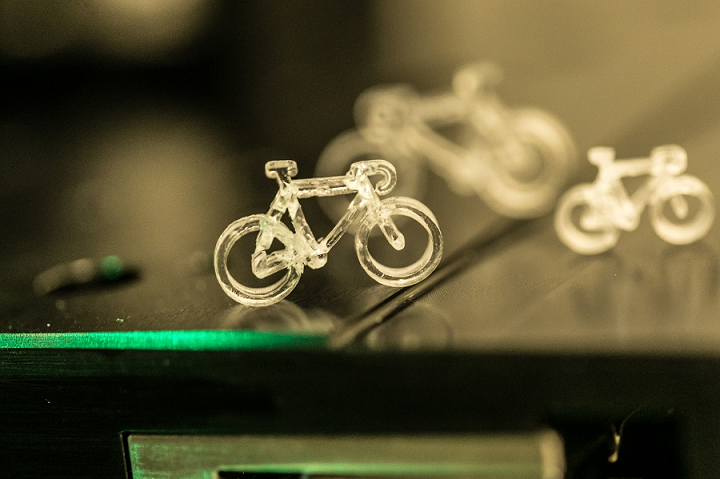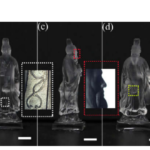

3D printing glass is a pretty tricky feat, mainly because it’s hard to maintain the material’s mechanical properties at its very high melting point. But a trio of researchers from France published a research paper in The Optical Society (OSA) journal Optics Letters about their work in creating a new laser-based method of printing intricate glass parts. The team used their newly developed technique, which is based on multiphoton polymerization, to print detailed glass objects without relying on the normal layer-by-layer fabrication of 3D printing, and believe that their method could possibly be used to 3D print complex optics for laser-based imaging and vision applications in the future.
“Glass is one of the primary materials used to make optics. Our work represents a first step toward developing a process that could one day allow scientists to 3D print the optical components they need,” said research team leader Laurent Gallais from The Fresnel Institute and Ecole Centrale Marseille.
Layer-by-layer 3D printing is not ideal for fabricating objects out of glass. With viscous resins, it’s tough to achieve layers that have consistent thicknesses, and supports are often needed for complex parts, which need to be removed at the end of the process…slowing the whole thing down even more.
“Most 3D printing processes build up an object layer by layer. Our new process avoids the limitations of these processes by using a laser beam to transform — or polymerize — a liquid precursor into solid glass,” Gallais explained.
With multiphoton polymerization, the process that links liquid monomer molecules into a solid polymer (aka polymerization) occurs at the exact laser focal point, which makes it possible to 3D print small, accurate parts that measure from just a few microns up to tens of centimeters at a great resolution. But, don’t get me wrong, it’s still a little complicated.
When you’re using this method to 3D print with glass, the specific material needs to be transparent at the laser’s wavelength during the initial liquid phase, and once it’s fully polymerized, as well. Additionally, it needs to absorb the light from the laser at half its wavelength in order to initiate multiphoton polymerization. So, the team used a mixture with a photochemical initiator to absorb the light, plenty of silica nanoparticles, and a resin to achieve this.

The abstract of the research paper states, “We introduce a laser-based process relying on multiphoton-induced polymerization to produce complex three-dimensional (3D) glass parts. A focused, intense laser beam is used to polymerize a transparent resin, loaded with additives and silica nanoparticles, at the wavelength of the laser beam through nonlinear absorption processes. The object is created directly in the volume, overcoming the limitation of the layer-by-layer process. The process enables the production of silica parts with consecutive debinding and sintering processes. With bulk silica density and a resolution that depends on the laser spot size, 3D objects of centimetric dimensions are obtained.”
The research team’s highly viscous mixture, which not only works with the laser, also makes it possible to 3D print a part without deformation issues, or the use of supports.
“Critical to the technique were high power ultrashort lasers based on Strickland and Mourou’s chirped pulse amplification technology recognized with a Nobel prize in 2018. Only intense and very short pulses will create non-linear photo polymerization with high precision and no thermal effects,” Gallais said.
Once they affirmed that they could use their silica nanoparticle mixture to make a solid object, the researchers 3D printed several complex glass objects without any cracks or pores, like a tiny Eiffel Tower and bicycle. Additionally, they were able to apply another process to their method that can transform the polymerized parts into glass ones.
Future work includes lowering the cost by using a less expensive laser, which will also help make the method more practical.
Gallais said, “Our approach could potentially be used to produce almost any type of 3D glass object. For example, we are exploring the possibility of producing glass parts that could be used on luxury watches or perfume bottles.”
The team also wants to improve the surface quality of glass parts 3D printed with its technique, which will help make the parts less rough.
(Source: Mirage News / Images: Laurent Gallais, The Fresnel Institute and Ecole Centrale Marseille)
If you're looking to get architectural 3D animation in the USA, our service provides an exceptional way to bring your architectural concepts to life through dynamic, immersive visuals. Through our platform, you can easily request high-quality 3D animations that showcase your designs in motion, offering a detailed view of your project from multiple angles and perspectives. Whether it's for a real estate development, a commercial building, or an urban planning project, our expert team ensures that every detail is captured in a visually compelling animation.
Through our website, you can seamlessly get architectural 3D animation tailored to your project’s specific needs. With our help, you can offer potential clients or investors an engaging experience that goes beyond static images. By integrating CGI animations with real-world settings, lighting, and textures, our team creates a lifelike experience that allows your audience to interact with your project as though it were already built. This service is perfect for presenting complex designs in a clear, visually attractive way that stands out in the competitive architectural market.




